Enhancing the High-Solid Anaerobic Digestion of Horticultural Waste by Adding Surfactants
Abstract
:1. Introduction
2. Results and Discussion
2.1. Effect of Adding Surfactants on Biogas Production in High-Solid Anaerobic Digestion
2.1.1. Adding Tween 20 in High-Solid Anaerobic Digestion
2.1.2. Adding Tween 60 in High-Solid Anaerobic Digestion
2.1.3. Adding Polyethylene Glycol 300 in High-Solid Anaerobic Digestion
2.2. Kinetic Analysis by Modified Gompertz Model
2.3. Biodegradability of Surfactants
2.4. Improvement in the Mechanism of High-Solid Anaerobic Digestion by Adding Surfactants
2.5. Economic Assessment
3. Materials and Methods
3.1. Feedstock and Inoculum
3.2. Surfactants
3.3. High-Solid Digestion
3.4. Kinetic Study
- Y—Cumulative methane production, N mL/g VS at any digestion time t;
- A—Methane yield potential, N mL/g VS;
- U—Maximum rate of methane production, N mL/(gVS·d);
- λ—Lag phase period to produce methane, days;
- t—Digestion time at which cumulative methane production Y is measured, d;
- e—Mathematical constant (2.718282).
3.5. Analysis Methods
3.6. Economic Analysis
4. Conclusions
Author Contributions
Funding
Data Availability Statement
Conflicts of Interest
Abbreviations
| anaerobic digestion | AD |
| Fourier transform infrared spectroscopy | FTIR |
| high-solid anaerobic digestion | HSAD |
| polyethylene glycol | PEG |
| Tween 20 | T20 |
| Tween 60 | T60 |
| Tween 80 | T80 |
| carbon | C |
| nitrogen | N |
| carbon-to-nitrogen ratio | C/N ratio |
| sulfur | S |
| total solid | TS |
| volatile solid | VS |
| neutral detergent solute | NDS |
| cumulative methane production at any digestion time | Y |
| methane yield potential | A |
| maximum rate of methane production | U |
| lag phase period to produce methane | λ |
| digestion time | t |
| mathematical constant | e |
References
- Hoornweg, D.; Bhada-Tata, P. What a waste: A global review of solid. Waste Manag. 2013, 116, 87–88. [Google Scholar]
- Mu, L.; Wang, Y.; Xu, F.; Li, J.; Tao, J.; Sun, Y.; Song, Y.; Duan, Z.; Li, S.; Chen, G. Emerging Strategies for Enhancing Propionate Conversion in Anaerobic Digestion: A Review. Molecules 2023, 28, 3883. [Google Scholar] [CrossRef] [PubMed]
- Zubair, M.; Li, Z.; Zhu, R.; Wang, J.; Liu, X.; Liu, X. The Antibiotics Degradation and Its Mechanisms during the Livestock Manure Anaerobic Digestion. Molecules 2023, 28, 4090. [Google Scholar] [CrossRef] [PubMed]
- Kalogiannis, A.; Vasiliadou, I.A.; Tsiamis, A.; Galiatsatos, I.; Stathopoulou, P.; Tsiamis, G.; Stamatelatou, K. Enhancement of Biodegradability of Chicken Manure via the Addition of Zeolite in a Two-Stage Dry Anaerobic Digestion Configuration. Molecules 2024, 29, 2568. [Google Scholar] [CrossRef] [PubMed]
- Hu, Y.; Wang, F.; Lv, G.; Chi, Y. Enhancing the Biogas Production of Sludge Anaerobic Digestion by a Combination of Zero-Valent Iron Foil and Persulfate. Energy Fuels 2019, 33, 7436–7442. [Google Scholar] [CrossRef]
- Zuo, X.; Yuan, H.; Wachemo, A.C.; Wang, X.; Zhang, L.; Li, J.; Wen, H.; Wang, J.; Li, X. The relationships among sCOD, VFAs, microbial community, and biogas production during anaerobic digestion of rice straw pretreated with ammonia. Chin. J. Chem. Eng. 2020, 28, 286–292. [Google Scholar] [CrossRef]
- Yang, Y.; Wang, J.; Zhou, Y. Enhanced Anaerobic Digestion of Swine Manure by the Addition of Zero-Valent Iron. Energy Fuels 2019, 33, 12441–12449. [Google Scholar] [CrossRef]
- Yuan, H.; Lan, Y.; Zhu, J.; Wachemo, A.C.; Li, X.; Yu, L. Effect on anaerobic digestion performance of corn stover by freezing–thawing with ammonia pretreatment. Chin. J. Chem. Eng. 2019, 27, 200–207. [Google Scholar] [CrossRef]
- Hagos, K.; Liu, C.; Lu, X. Effect of endogenous hydrogen utilization on improved methane production in an integrated microbial electrolysis cell and anaerobic digestion: Employing catalyzed stainless steel mesh cathode. Chin. J. Chem. Eng. 2018, 26, 574–582. [Google Scholar] [CrossRef]
- Lü, H.; Zhou, J.; Liu, J.; Lü, C.; Lian, F.; Li, Y. Optimization of hydrothermal pretreatment for co-utilization of xylose and glucose of cassava anaerobic residue for producing ethanol. Chin. J. Chem. Eng. 2019, 27, 920–927. [Google Scholar] [CrossRef]
- Li, W.; Loh, K.-C.; Zhang, J.; Tong, Y.W.; Dai, Y. Two-stage anaerobic digestion of food waste and horticultural waste in high-solid system. Appl. Energy 2018, 209, 400–408. [Google Scholar] [CrossRef]
- Li, W. High-Solid Anaerobic Codigestion of Horse Manure and Grass in Batch and Semi-continuous Systems. Energy Fuels 2016, 30, 6419–6424. [Google Scholar] [CrossRef]
- Lenz, J.; Hölker, U.; Höfer, M. Biotechnological advantages of laboratory-scale solid-state fermentation with fungi. Appl. Microbiol. Biotechnol. 2004, 64, 175–186. [Google Scholar] [CrossRef]
- Li, W.; Lu, C.; An, G.; Chang, S. Comparison of Alkali-Buffering Effects and Co-digestion on High-Solid Anaerobic Digestion of Horticultural Waste. Energy Fuels 2017, 31, 10990–10997. [Google Scholar] [CrossRef]
- An, Q.; Lin, H.-N.; Wang, Y.-T.; Deng, M.-C.; Zhu, M.-J. Improved saccharification of pretreated lignocellulose by Clostridium thermocellum with the addition of surfactant, low loading of cellulose. Process. Biochem. 2021, 111, 267–273. [Google Scholar] [CrossRef]
- Snehya, A.; Sundaramahalingam, M.; Rajeshbanu, J.; Anandan, S.; Sivashanmugam, P. Studies on evaluation of surfactant coupled sonication pretreatment on Ulva fasciata (marine macroalgae) for enhanced biohydrogen production. Ultrason. Sonochemistry 2021, 81, 105853. [Google Scholar] [CrossRef] [PubMed]
- Leaño, E.P.; Babel, S. The influence of enzyme and surfactant on biohydrogen production and electricity generation using Palm Oil Mill Effluent. J. Clean. Prod. 2012, 31, 91–99. [Google Scholar] [CrossRef]
- Elsamadony, M.; Tawfik, A.; Suzuki, M. Surfactant-enhanced biohydrogen production from organic fraction of municipal solid waste (OFMSW) via dry anaerobic digestion. Appl. Energy 2015, 149, 272–282. [Google Scholar] [CrossRef]
- Chen, Y.-A.; Zhou, Y.; Qin, Y.; Liu, D.; Zhao, X. Evaluation of the action of Tween 20 non-ionic surfactant during enzymatic hydrolysis of lignocellulose: Pretreatment, hydrolysis conditions and lignin structure. Bioresour. Technol. 2018, 269, 329–338. [Google Scholar] [CrossRef]
- Hamawand, I. Anaerobic digestion process and bio-energy in meat industry: A review and a potential. Renew. Sustain. Energy Rev. 2015, 44, 37–51. [Google Scholar] [CrossRef]
- Braz, L.M.; Costa, J.M.; Aguiar, A.B.S.; Rodriguez, R.P.; Sancinetti, G.P. Management and kinetics of methane production from anaerobic batch reactors treating PET bottle washing wastewater. J. Water Process. Eng. 2021, 43. [Google Scholar] [CrossRef]
- Pérez-Armendáriz, B.; Moreno, Y.M.; Monroy-Hermosillo, O.; Guyot, J.P.; González, R.O. Anaerobic Biodegradability and Inhibitory Effects of Some Anionic and Cationic Surfactants. Bull. Environ. Contam. Toxicol. 2010, 85, 269–273. [Google Scholar] [CrossRef] [PubMed]
- Mekwichai, P.; Chutivisut, P.; Tuntiwiwattanapun, N. Enhancing biogas production from palm oil mill effluent through the synergistic application of surfactants and iron supplements. Heliyon 2024, 10, e29617. [Google Scholar] [CrossRef] [PubMed]
- Alkasrawi, M.; Eriksson, T.; Börjesson, J.; Wingren, A.; Galbe, M.; Tjerneld, F.; Zacchi, G. The effect of Tween-20 on simultaneous saccharification and fermentation of softwood to ethanol. Enzym. Microb. Technol. 2003, 33, 71–78. [Google Scholar] [CrossRef]
- Patel, P.; Madamwar, D. Surfactants in anaerobic digestion of salty cheese whey using upflow fixed film reactor for improved biomethanation. Process. Biochem. 1998, 33, 199–203. [Google Scholar] [CrossRef]
- Yue, Z.-B.; Yu, H.-Q.; Hu, Z.-H.; Harada, H.; Li, Y.-Y. Surfactant-enhanced anaerobic acidogenesis of Canna indica L. by rumen cultures. Bioresour. Technol. 2008, 99, 3418–3423. [Google Scholar] [CrossRef]
- Goodwin, J. Colloids and Interfaces with Surfactants and Polymers; John Wiley & Sons Ltd.: Hoboken, NJ, USA, 2009; Volume 40. [Google Scholar]
- Huang, Y.-L.; Li, Q.-B.; Deng, X.; Lu, Y.-H.; Liao, X.-K.; Hong, M.-Y.; Wang, Y. Aerobic and anaerobic biodegradation of polyethylene glycols using sludge microbes. Process. Biochem. 2005, 40, 207–211. [Google Scholar] [CrossRef]
- Eckard, A.D.; Muthukumarappan, K.; Gibbons, W. A Review of the Role of Amphiphiles in Biomass to Ethanol Conversion. Appl. Sci. 2013, 3, 396–419. [Google Scholar] [CrossRef]
- Wu, J.; Ju, L. Enhancing Enzymatic Saccharification of Waste Newsprint by Surfactant Addition. Biotechnol. Prog. 1998, 14, 649–652. [Google Scholar] [CrossRef]
- Muharja, M.; Umam, D.K.; Pertiwi, D.; Zuhdan, J.; Nurtono, T.; Widjaja, A. Enhancement of sugar production from coconut husk based on the impact of the combination of surfac-tant-assisted subcritical water and enzymatic hydrolysis. Bioresour. Technol. 2019, 274, 89–96. [Google Scholar] [CrossRef]
- Fang, Z.F.; Liu, K.L.; Chen, F.S.; Zhang, L.F.; Guo, Z. Cationic surfactant-assisted microwave-NaOH pretreatment for enhancing enzymatic hydrolysis and fer-mentable sugar yield from peanut shells. BioResources 2014, 9, 1290–1302. [Google Scholar] [CrossRef]
- Singh, L.; Siddiqui, M.F.; Ahmad, A.; Rahim, M.H.; Sakinah, M.; Wahid, Z.A. Application of polyethylene glycol immobilized Clostridium sLS2 for continuous hydrogen production from palm oil mill effluent in upflow anaerobic sludge blanket reactor. Biochem. Eng. J. 2013, 70, 158–165. [Google Scholar] [CrossRef]
- Merrettig-Bruns, U.; Jelen, E. Anaerobic Biodegradation of Detergent Surfactants. Materials 2009, 2, 181–206. [Google Scholar] [CrossRef]
- Petroudy, S.R.D.; Rahmani, N.; Garmaroody, E.R.; Rudi, H.; Ramezani, O. Comparative study of cellulose and lignocellulose nanopapers prepared from hard wood pulps: Morphological, structural and barrier properties. Int. J. Biol. Macromol. 2019, 135, 512–520. [Google Scholar] [CrossRef] [PubMed]
- Börjesson, J.; Peterson, R.; Tjerneld, F. Enhanced enzymatic conversion of softwood lignocellulose by poly(ethylene glycol) addition. Enzym. Microb. Technol. 2007, 40, 754–762. [Google Scholar] [CrossRef]
- Petroudy, S.R.D.; Ranjbar, J.; Garmaroody, E.R. Eco-friendly superabsorbent polymers based on carboxymethyl cellulose strengthened by TEMPO-mediated oxidation wheat straw cellulose nanofiber. Carbohydr. Polym. 2018, 197, 565–575. [Google Scholar] [CrossRef]
- Gaspar, D.; Fernandes, S.N.; de Oliveira, A.G.; Fernandes, J.G.; Grey, P.; Pontes, R.V.; Pereira, L.; Martins, R.; Godinho, M.H.; Fortunato, E. Nanocrystalline cellulose applied simultaneously as the gate dielectric and the substrate in flexible field effect transistors. Nanotechnology 2014, 25, 094008. [Google Scholar] [CrossRef]
- Li, Z.; Ge, Y. Extraction of lignin from sugar cane bagasse and its modification into a high performance dispersant for pesticide formulations. J. Braz. Chem. Soc. 2011, 22, 1866–1871. [Google Scholar] [CrossRef]
- Seo, D.-J.; Fujita, H.; Sakoda, A. Effects of a non-ionic surfactant, Tween 20, on adsorption/desorption of saccharification en-zymes onto/from lignocelluloses and saccharification rate. Adsorption 2011, 17, 813–822. [Google Scholar] [CrossRef]
- Biasutti, M.A.; Abuin, E.B.; Silber, J.J.; Correa, N.M.; Lissi, E.A. Kinetics of reactions catalyzed by enzymes in solutions of surfactants. Adv. Colloid Interface Sci. 2008, 136, 1–24. [Google Scholar] [CrossRef]
- Kim, M.; Lee, S.; Ryu, D.D.; Reese, E. Surface deactivation of cellulase and its prevention. Enzym. Microb. Technol. 1982, 4, 99–103. [Google Scholar] [CrossRef]
- Vo, T.T.Q.; Wall, D.M.; Ring, D.; Rajendran, K.; Murphy, J.D. Techno-economic analysis of biogas upgrading via amine scrubber, carbon capture and ex-situ methanation. Appl. Energy 2018, 212, 1191–1202. [Google Scholar] [CrossRef]
- Molaey, R.; Bayrakdar, A.; Sürmeli, R.; Çalli, B. Anaerobic digestion of chicken manure: Influence of trace element supplementation. Eng. Life Sci. 2018, 19, 143–150. [Google Scholar] [CrossRef] [PubMed]
- Zwietering, M.H.; Jongenburger, I.; Rombouts, F.M.; Van’t Riet, K.J. Modeling of the Bacterial Growth Curve. Appl. Environ. Microbiol. 1990, 56, 1875–1881. [Google Scholar] [CrossRef] [PubMed]
- APHA. Standard Methods for the Examination of Water and Wastewater; American Public Health Association: Washington, DC, USA, 2005. [Google Scholar]
- Van Soest, P.J.; Robertson, J.B.; Lewis, B.A. Methods for dietary fiber, neutral detergent fiber, and nonstarch polysaccharides in relation to animal nutrition. J. Dairy Sci. 1991, 74, 3583–3597. [Google Scholar] [CrossRef] [PubMed]
- Kaczala, F.; Marques, M.; Hogland, W. Biotreatability of wastewater generated during machinery washing in a wood-based industry: COD, formaldehyde and nitrogen removal. Bioresour. Technol. 2010, 101, 8975–8983. [Google Scholar] [CrossRef]
- Molinos-Senante, M.; Hernández-Sancho, F.; Sala-Garrido, R. Economic feasibility study for wastewater treatment: A cost–benefit analysis. Sci. Total. Environ. 2010, 408, 4396–4402. [Google Scholar] [CrossRef]
- Cho, S.-K.; Ju, H.-J.; Lee, J.-G.; Kim, S.-H. Alkaline-mechanical pretreatment process for enhanced anaerobic digestion of thickened waste activated sludge with a novel crushing device: Performance evaluation and economic analysis. Bioresour. Technol. 2014, 165, 183–190. [Google Scholar] [CrossRef]
- Nasr, M.; Tawfik, A.; Ookawara, S.; Suzuki, M. Environmental and Economic Aspects of Hydrogen and Methane Production from Starch Wastewater Industry. J. Water Environ. Technol. 2013, 11, 463–475. [Google Scholar] [CrossRef]
- Li, Y.; Chen, Y.; Wu, J. Enhancement of methane production in anaerobic digestion process: A review. Appl. Energy 2019, 240, 120–137. [Google Scholar] [CrossRef]
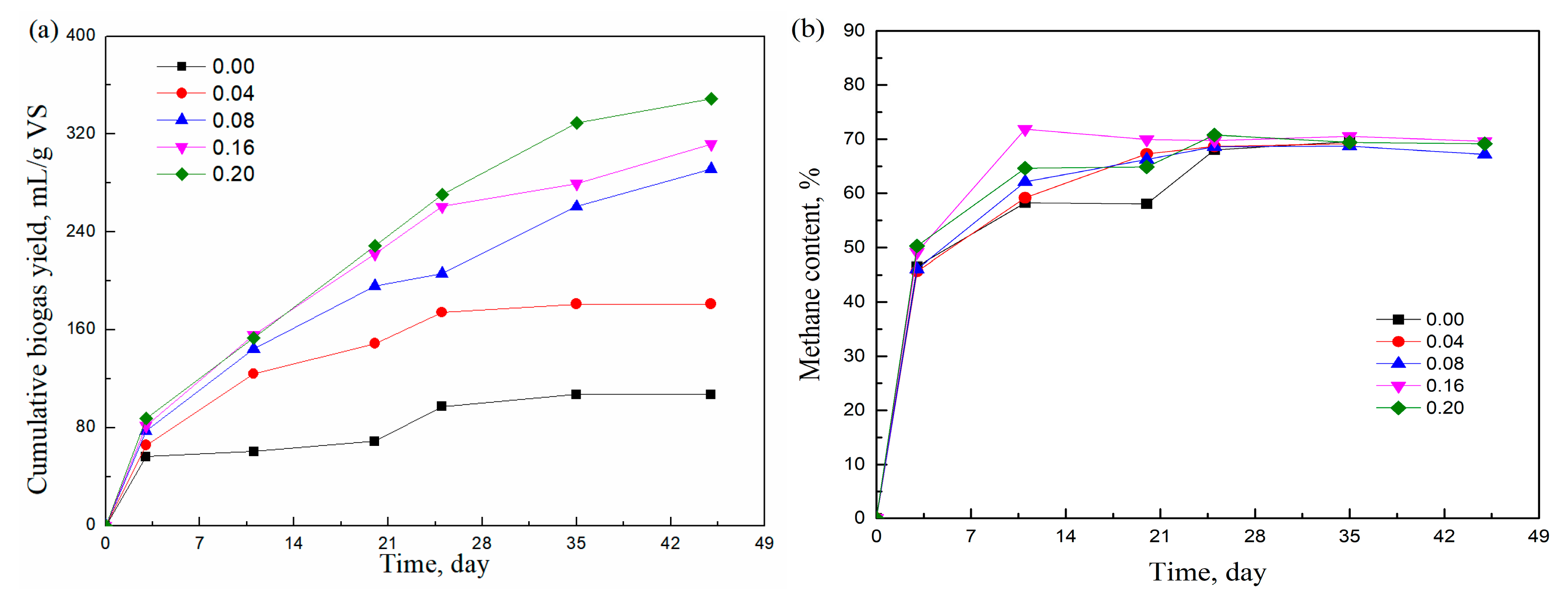
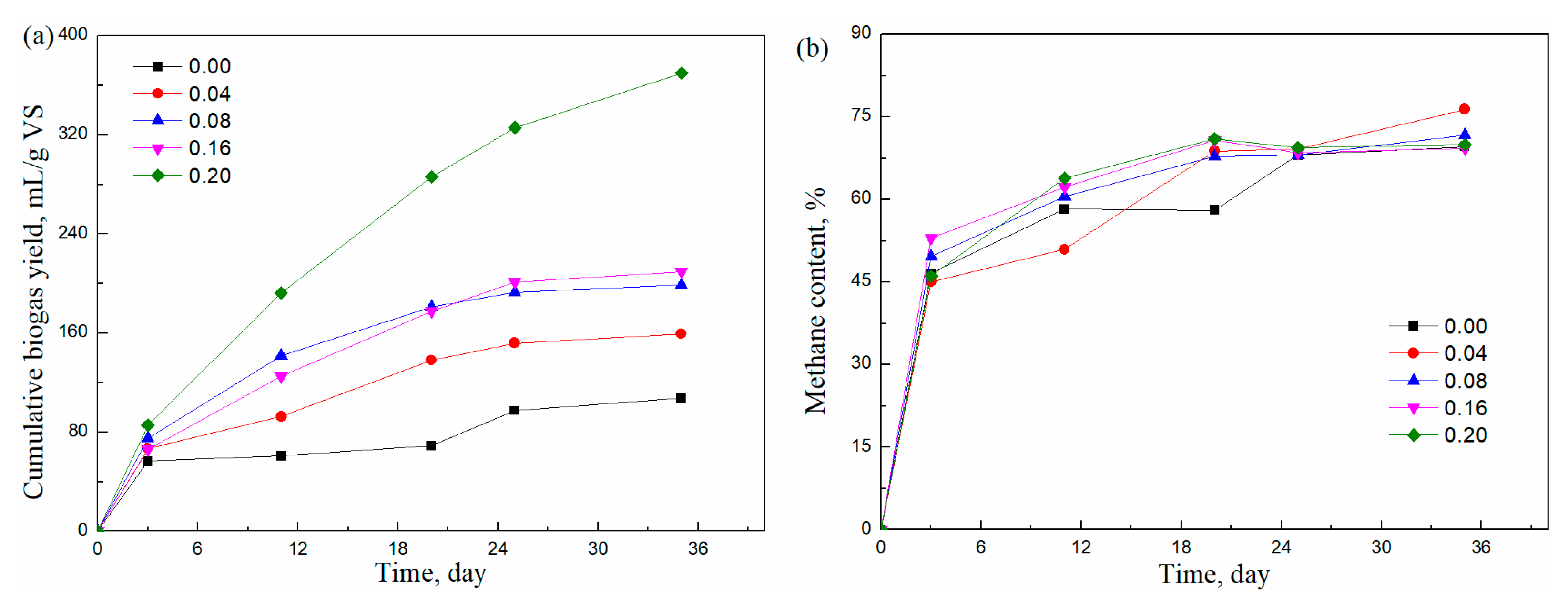

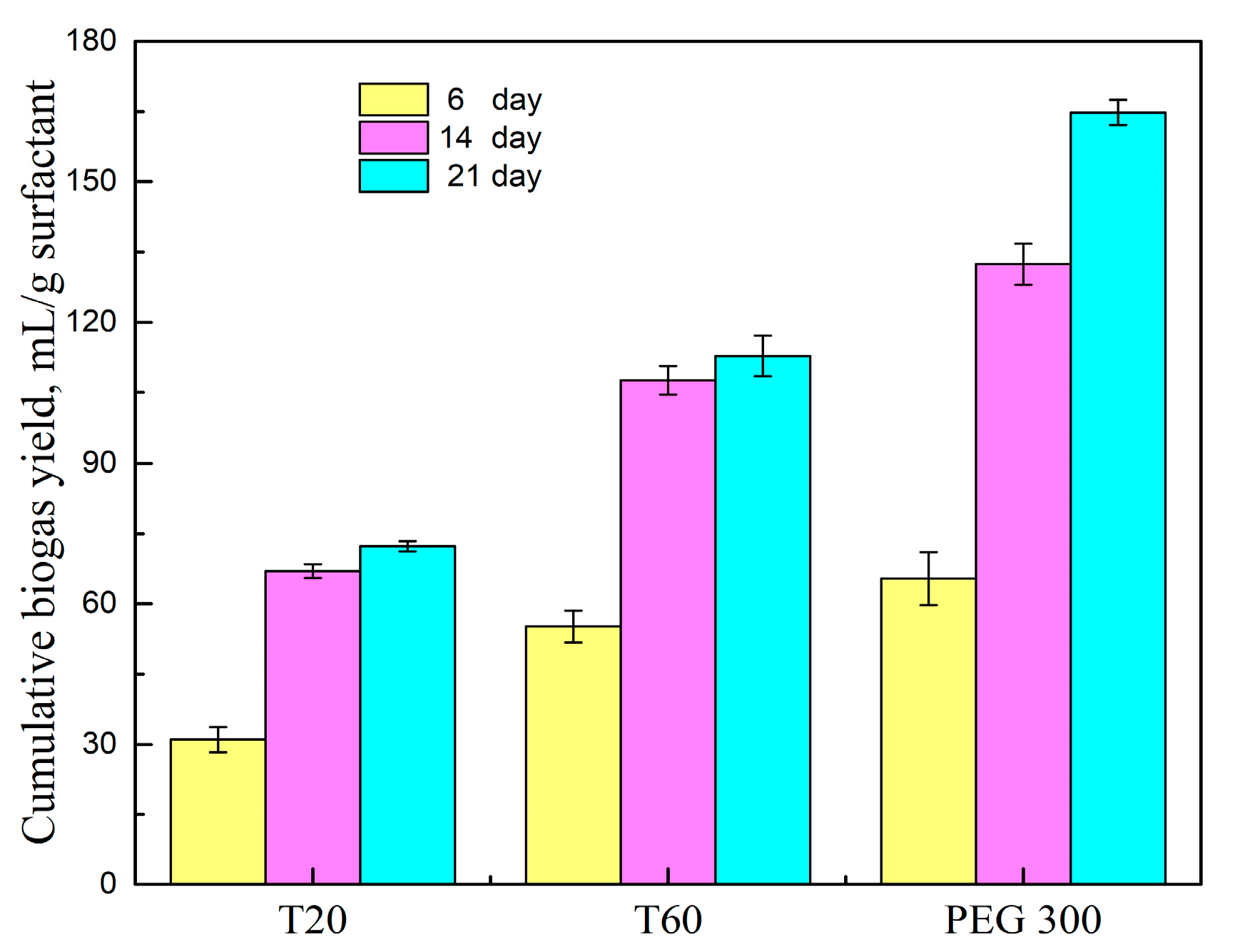
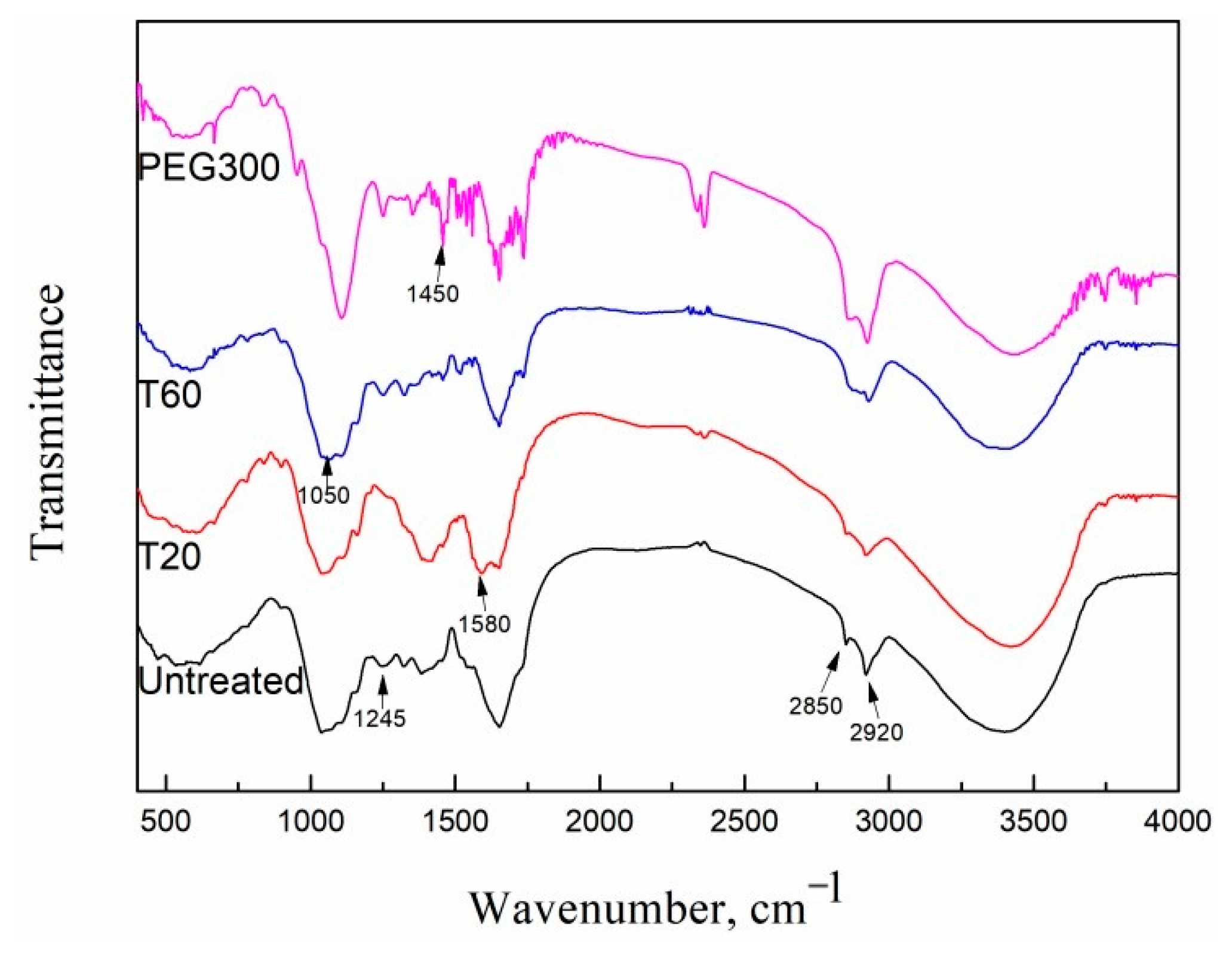
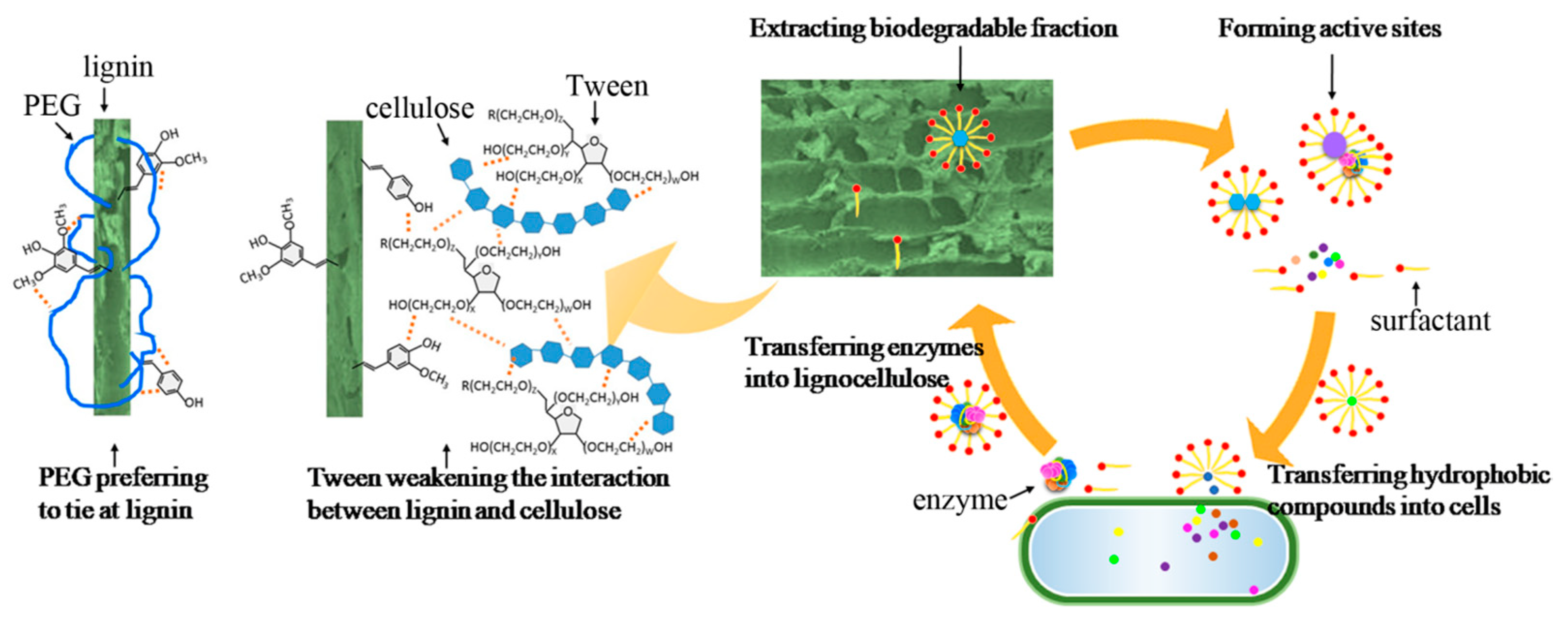
| T20/Grass | pH | Ammonia, mg/g TS | SCOD, mg/g TS | VS, % | VS Removal, % |
|---|---|---|---|---|---|
| 0.00 | 7.68 ± 0.08 | 4.52 ± 0.16 | 613.9 ± 3.00 | 9.99 ± 0.01 | 50.0 |
| 0.04 | 7.33 ± 0.09 | 4.49 ± 0.08 | 321.6 ± 4.66 | 8.29 ± 0.05 | 58.55 |
| 0.08 | 7.65 ± 0.04 | 5.92 ± 0.14 | 48.3 ± 2.13 | 7.83 ± 0.09 | 60.85 |
| 0.16 | 7.69 ± 0.10 | 5.72 ± 0.05 | 19.4 ± 8.96 | 7.53 ± 0.04 | 62.35 |
| 0.20 | 7.54 ± 0.20 | 5.91 ± 0.17 | 5.3 ± 7.11 | 7.13 ± 0.06 | 64.35 |
| T60/Grass | pH | Ammonia, mg/g TS | SCOD, mg/g TS | VS, % | VS Removal, % |
|---|---|---|---|---|---|
| 0 | 7.68 ± 0.08 | 4.52 ± 0.16 | 613.9 ± 3.00 | 9.99 ± 0.01 | 50.0 |
| 0.04 | 7.57 ± 0.03 | 4.85 ± 0.09 | 485.1 ± 6.06 | 9.76 ± 0.09 | 51.2 |
| 0.08 | 7.7 ± 0.11 | 6.39 ± 0.15 | 85.8 ± 9.82 | 9.56 ± 0.04 | 52.2 |
| 0.16 | 7.63 ± 0.06 | 6.72 ± 0.12 | 43.9 ± 5.79 | 9.48 ± 0.08 | 52.6 |
| 0.20 | 7.56 ± 0.02 | 7.43 ± 0.10 | 0 ± 2.61 | 6.83 ± 0.11 | 65.9 |
| Batches | A (N mL/g VS) | λ (d) | U (N mL/(gVS·d)) | R2 |
|---|---|---|---|---|
| Control (0%) | 64.0 ± 10.8 | 0.0 ± 0.0 | 2.25 ± 0.5 | 0.807 |
| Effect of T20 | ||||
| 0.04 | 102.7 ± 6.1 | 0.0 ± 1.8 | 5.63 ± 1.2 | 0.956 |
| 0.08 | 181.7 ± 19.7 | 0.0 ± 2.7 | 5.68 ± 1.1 | 0.952 |
| 0.16 | 200.5 ± 12.2 | 0.0 ± 1.7 | 7.64 ± 1.1 | 0.977 |
| 0.20 | 234.5 ± 18.2 | 0.0 ± 1.9 | 7.17 ± 0.9 | 0.978 |
| Effect of T60 | ||||
| 0.04 | 94.0 ± 12.6 | 0.0 ± 2.8 | 4.27 ± 1.2 | 0.920 |
| 0.08 | 115.9 ± 8.6 | 0.0 ± 1.8 | 7.07 ± 1.7 | 0.954 |
| 0.16 | 133.9 ± 10.5 | 0.0 ± 1.7 | 6.65 ± 1.3 | 0.967 |
| 0.20 | 243.9 ± 15.6 | 0.5 ± 1.2 | 9.92 ± 1.1 | 0.988 |
| Effect of PEG 300 | ||||
| 0.04 | 32.4 ± 4.0 | -0.2 ± 3.9 | 2.08 ± 0.9 | 0.715 |
| 0.08 | 102.7 ± 19.2 | 5.2 ± 4.7 | 3.17 ± 1.1 | 0.816 |
| 0.16 | 146.5 ± 3.9 | 8.8 ± 0.6 | 6.32 ± 0.4 | 0.995 |
| 0.20 | 176.1 ± 5.5 | 10.0 ± 0.7 | 13.9 ± 1.5 | 0.988 |
| T20 | T20 | T20 | T60 | PEG300 | ||
|---|---|---|---|---|---|---|
| Surfactant per gram of grass | g/g TS | 0.08 | 0.16 | 0.20 | 0.20 | 0.20 |
| Methane per gram of grass | mL/g TS | 153.2 ± 6.8 | 175.4 ± 7.3 | 190.1 ± 2.6 | 201.7 ± 4.7 | 149.3 ± 5.5 |
| Extra methane per gram of grass | mL/g TS | 101.3 | 123.5 | 138.2 | 149.8 | 97.4 |
| Profit of extra methane | EUR/Kg TS | 0.17 | 0.20 | 0.23 | 0.25 | 0.16 |
| Price of surfactant | EUR/kg | 1.77 ± 0.36 | 1.77 ± 0.36 | 1.77 ± 0.36 | 1.79 ± 0.31 | 1.39 ± 0.25 |
| Cost of surfactant input | EUR | 0.14 | 0.28 | 0.35 | 0.36 | 0.28 |
| Ratiocost | 0.85 | 1.39 | 1.55 | 1.45 | 1.73 |
| Feed | Grass | Anaerobic Sludge |
|---|---|---|
| C, wt% | 41.08 ± 0.70 | 43.96 ± 2.08 |
| N, wt% | 1.02 ± 0.02 | 2.40 ± 0.05 |
| C/N ratio | 40.27 | 18.32 |
| S, wt% | <0.50 ± 0.04 | 0.67 ± 0.06 |
| Total solid (TS),% | 80.58 ± 0.98 | 21.25 ± 1.14 |
| Volatile solid (VS),% Composition | 69.81 ± 0.07 | 18.97 ± 0.05 |
| NDS, % | 16.68 ± 1.58 | 32.67 ± 1.77 |
| Cellulose, % | 42.49 ± 1.45 | 24.11 ± 1.15 |
| Hemicelluloses, % | 27.14 ± 1.37 | 19.52 ± 2.04 |
| Lignin, % | 12.67 ± 2.67 | 15.37 ± 2.85 |
| Ash, % | 0.67 ± 0.55 | 7.96 ± 0.71 |
| Parameter | Tween 20 | Tween 60 | PEG 300 |
|---|---|---|---|
| Molecular formula | C58H113O26 | C64H126O26 | HO(CH2CH2O)nH |
| Shape | Yellow viscous liquid | Yellow or orange oily liquid or semi-gel | Colorless transparent liquid |
| Molar weight (g/mol) | 1226.48 | 1311.68 | ~300 |
| Density(g/mL) | 1.095 g/mL at 25 °C | 1.044 g/mL at 25 °C | - |
Disclaimer/Publisher’s Note: The statements, opinions and data contained in all publications are solely those of the individual author(s) and contributor(s) and not of MDPI and/or the editor(s). MDPI and/or the editor(s) disclaim responsibility for any injury to people or property resulting from any ideas, methods, instructions or products referred to in the content. |
© 2024 by the authors. Licensee MDPI, Basel, Switzerland. This article is an open access article distributed under the terms and conditions of the Creative Commons Attribution (CC BY) license (https://creativecommons.org/licenses/by/4.0/).
Share and Cite
Li, W.; Zhang, Z.; Mi, S.; Zhao, S. Enhancing the High-Solid Anaerobic Digestion of Horticultural Waste by Adding Surfactants. Molecules 2024, 29, 4061. https://doi.org/10.3390/molecules29174061
Li W, Zhang Z, Mi S, Zhao S. Enhancing the High-Solid Anaerobic Digestion of Horticultural Waste by Adding Surfactants. Molecules. 2024; 29(17):4061. https://doi.org/10.3390/molecules29174061
Chicago/Turabian StyleLi, Wangliang, Zhikai Zhang, Shuzhen Mi, and Shengyong Zhao. 2024. "Enhancing the High-Solid Anaerobic Digestion of Horticultural Waste by Adding Surfactants" Molecules 29, no. 17: 4061. https://doi.org/10.3390/molecules29174061
APA StyleLi, W., Zhang, Z., Mi, S., & Zhao, S. (2024). Enhancing the High-Solid Anaerobic Digestion of Horticultural Waste by Adding Surfactants. Molecules, 29(17), 4061. https://doi.org/10.3390/molecules29174061






